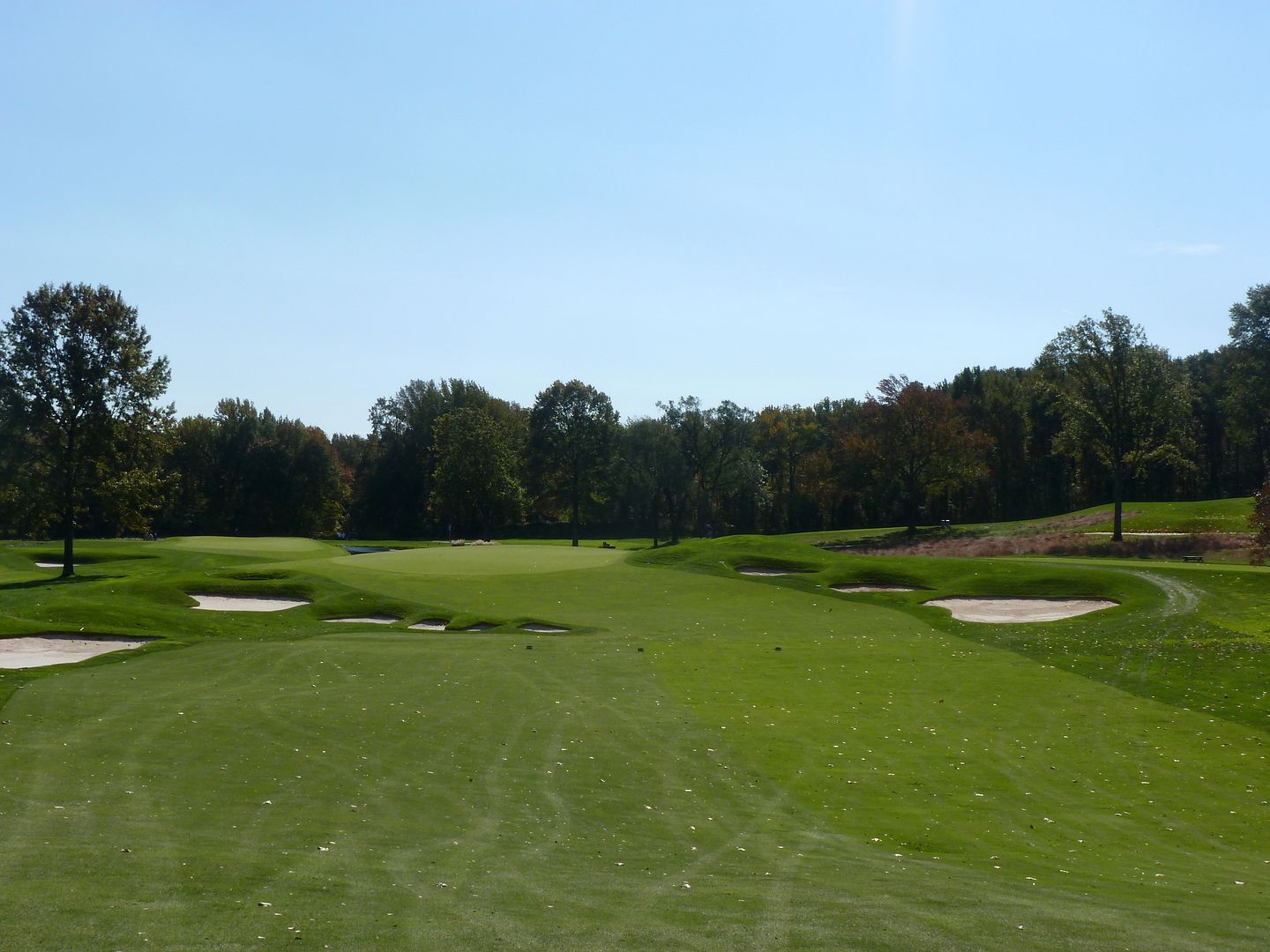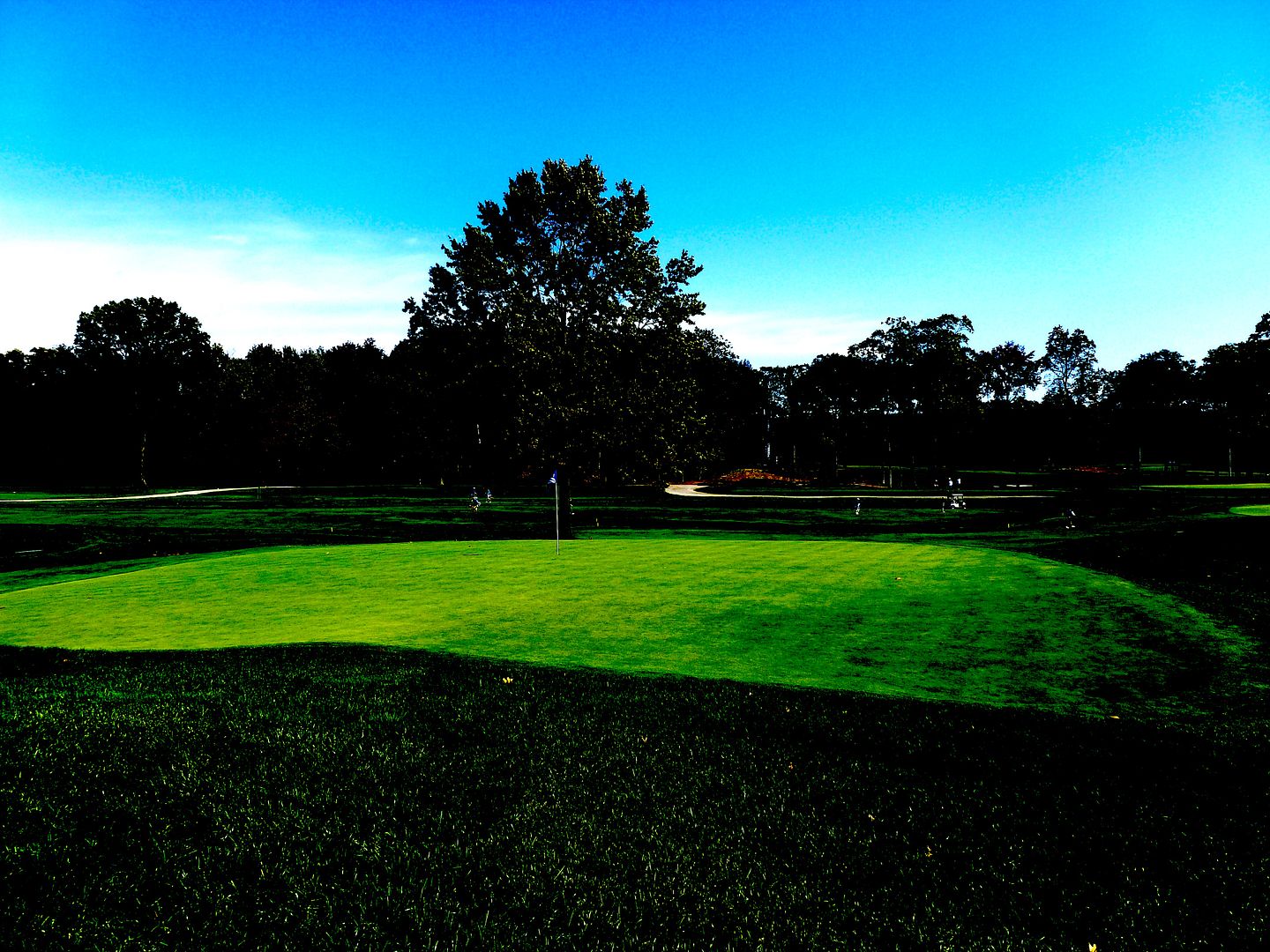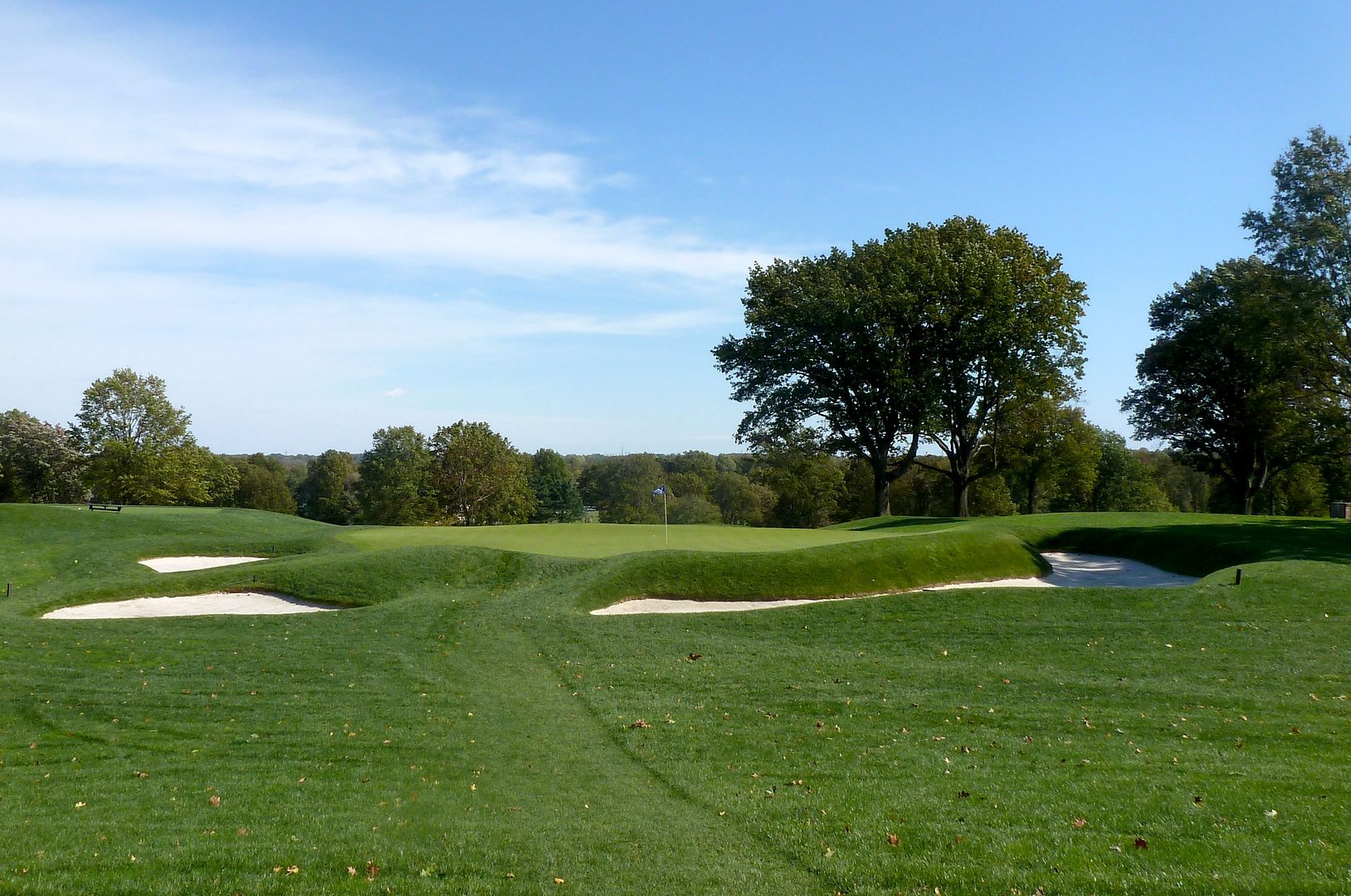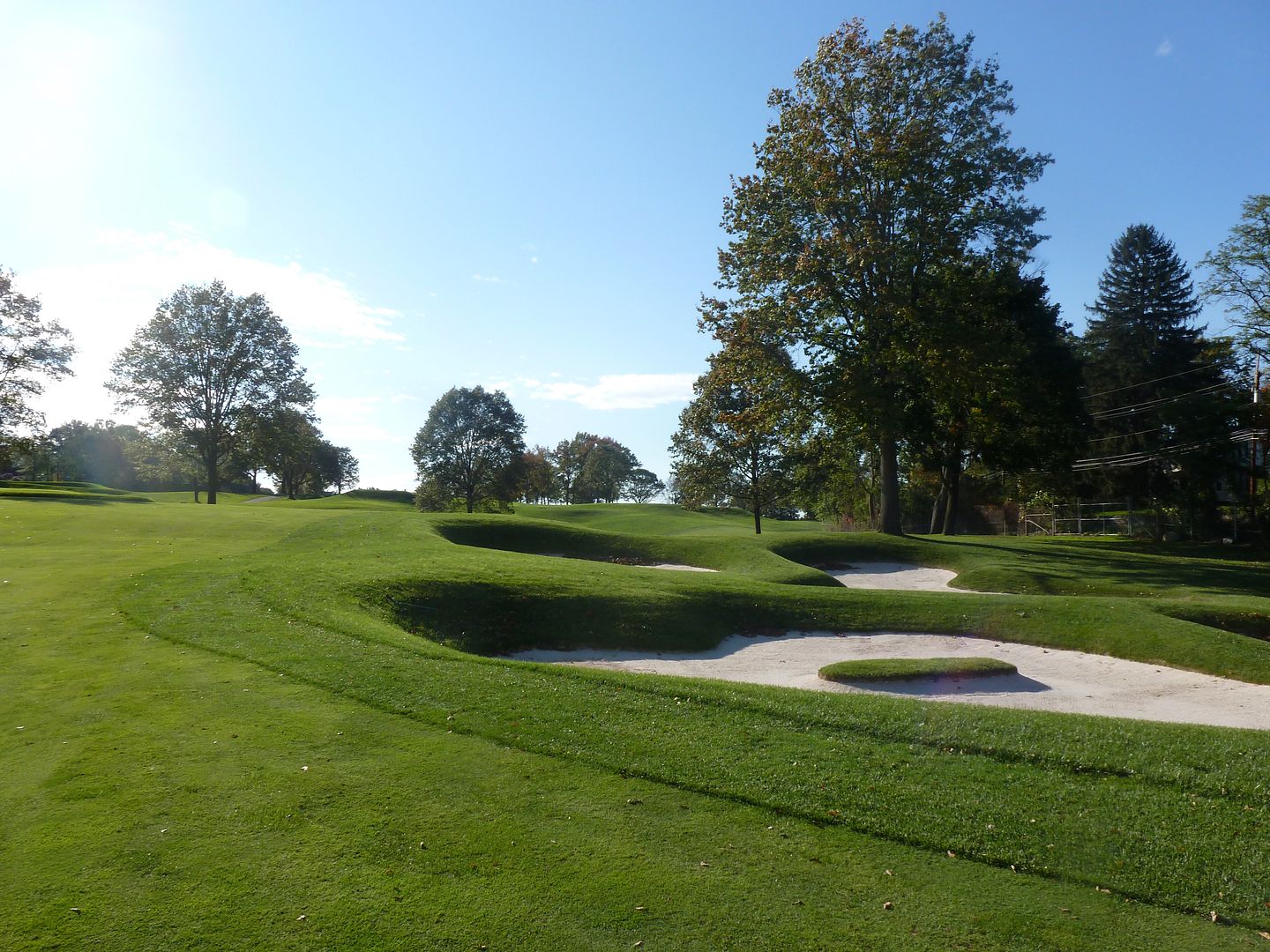Edison, New Jersey, USA
Architects: Donal Ross (1921); Restoration by Gil Hanse (2008)
Yardage: 7,125 Yards, Par 72
Rating/Slope: 75.3/146
My Quick Review: A wonderfully intimate routing, a great set of greens, and it might the best Donald Ross designed golf course (yep, better than Pinehurst No. 2!).
My Thoughts
Even though Plainfield CC is consistently ranked among the 100 best golf courses in the United States by Golf Digest and Golf Magazine, and Golfweek Magazine has it in the top-30 Classic courses, I feel that Plainfield is underrated. Having visited the course since the Hanse restoration, I am very comfortable saying Plainfield belongs among the top 40 golf courses in the country. If not for the weak stretch of holes from 13-15 (not Ross originals), the course would be almost without fault.
The Routing
Not surprisingly, the Ross routing is exceptional. Like the two courses at Oakland Hills near Detroit, MI, Plainfield is routed over an ancient glacial ridge. The clubhouse, practice area and first tee are located on flat land at the highest point on the property, but the golf course is routed over perfect-for-golf rolling terrain.
The routing gives a tremendous sense of intimacy. The front-nine coils around itself, constantly changing direction and working its way across the large ridge that slopes down, away from the clubhouse. Based on this single ridge, the front-nine has holes that play uphill, downhill, left-sloping and right-sloping.
Also of note is the 'previewing the shot' aspect, discussed a couple of times earlier on GolfClubAtlas.com:
http://www.golfclubatlas.com/forum/index.php/topic,29282.0.html
http://www.golfclubatlas.com/forum/index.php/topic,43475.0.html
On the 2nd tee, you get a very good look at the entirety of the devilish 11th hole. Some of the green slopes that are not easily noticeable from the 11th tee, can be taken in by the perceptive player from the 2nd tee.
Similarly, the 7th hole has bunkering that ends well short of the green and a feeder slope that can be used, but these cannot possibly be seen from the 7th fairway. Walking past the 7th, on the 4th hole, these features are easily recognizable and a clever player (or a good caddie) will make note of this.
Lastly, the course has a great 'hub', another feature I first noticed at Old Town (how darned good is that Old Town routing!!). The 1st green, 2nd tee, 8th green, 9th tee, 11th green and 12th are all very close to each other, contributing to the sense of intimacy.
 |
| Clubhouse as Seen from 9th Tee |
The greens have some of the most dramatic combinations of tilt and slope I have ever seen. More than any Ross course I have seen, the greens lay naturally on the land, as if they were meant to be there.
Not only are the greens tremendously natural in feel, they are also tremendously varied and difficult. In the first three holes there alone, there is a green that slopes severely from back-left to front-right, a green that is turtle-backed, and a green that is a bowl (opposite of a turtle-back). One theme is common, however, never miss long at Plainfield.
Holes to Note
Hole 1: Par 4, 432 Yards
I will include the text from Plainfield's website detailing the recent Gil Hanse restoration work on each hole.
Webiste commentary: What a terrific opening hole and a great introduction to the course! Ross wanted the ball to move along the ground but this is a good example of a fairway that had become too narrow, so we widened it on the left side, which is the best side for approach to the green. We also expanded the collar to the right of the green. Before we did that, if you missed the green to the right you were dead. We also put in chipping areas, which give you the options of putting, chipping, pitching or hitting a high flop shot as opposed to just gouging the ball out of the rough. We also removed the trees behind the green, which is something we did on several of the holes. They were not part of the original Ross design and they provided depth perception that ran counter to Ross's philosophy.
 |
| Sign on 1st Tee |
 |
| 1st Tee |
Many tee shots will find a bowl in the fairway that is about 240 yards from the tee (leaves 160ish into the green). From here the approach is partially blind and it is very difficult to get a good feel for the contouring on and short of the green.
 |
| 1st Approach from 160 Yards |
Bombers who can carry the bowl (a carry of about 260 yards) and successfully avoid the left-hand fairway bunker are left with this approach:
A wonderful and natural greensite. The land short of the green slopes from right-to-left and towards the tee, and guess what, so does the green! Also note the depth of the greenside bunkering (something I have noticed Ross varies wonderfully). While the bunker on the left is considerably deeper than the bunker on the right, it is by far the better place to miss.
 |
| 1st Greensite |
The green has as much tilt as any green I've seen. Being above the hole or missing the green to the right is dead.
So much for a gimme opener. Oh yeah, missing long is worst of all:
Standing on the second tee, you can watch golfers playing the short 11th. I watched as an entire foursome teed off on the 12th.
http://www.golfclubatlas.com/forum/index.php/topic,29282.0.html
http://www.golfclubatlas.com/forum/index.php/topic,43475.0.html
Here's the view of the 11th green from the 2nd tee -- note how many of the players in the foursome found the green!
Hole 2: Par 4, 443 Yards
This is a hole where we restored the original Ross complex of bunkers, which were much more intricate and thoughtful than the evolved configuration that we inherited. There's a chipping area to the left of the putting surface that will see a lot of play. This is another hole where we removed the trees behind the green, taking away the artificial backdrop and opening up views to the beautiful third hole.
A downhill tee shot to a fairway that slopes significantly right-to-left. A single bunker 240 yards off the tee guards the ideal line down the right. Bunkers 290 yards from the tee will catch tee shots that run too far with the slope.
Many well-struck tee shots played not quite far enough to the right will run into the left rough, leaving this approach:
So much for a gimme opener. Oh yeah, missing long is worst of all:
 |
| 1st Long of Green |
Standing on the second tee, you can watch golfers playing the short 11th. I watched as an entire foursome teed off on the 12th.
http://www.golfclubatlas.com/forum/index.php/topic,29282.0.html
http://www.golfclubatlas.com/forum/index.php/topic,43475.0.html
Here's the view of the 11th green from the 2nd tee -- note how many of the players in the foursome found the green!
 |
| 11th Green as seen from 2nd Tee |
This is a hole where we restored the original Ross complex of bunkers, which were much more intricate and thoughtful than the evolved configuration that we inherited. There's a chipping area to the left of the putting surface that will see a lot of play. This is another hole where we removed the trees behind the green, taking away the artificial backdrop and opening up views to the beautiful third hole.
 |
| 2nd tee |
 |
| 2nd Fairway |
 |
| Approach from Left |
 |
| Approach from Centre |
Approaches can use the contouring short-right of the green to run the ball onto the green, but this is best accomplished from the hard-to-find right side of the fairway.
 |
| Short of Green |
 |
| View from Green back towards Tee |
Another fantastic green at the 2nd. This green is turtle-backed with a false-front. There is a chipping area to the left of the green that leaves a very difficult recovery.
 |
| Green from Back-Right |
 |
| Green from Right |
 |
| Green from Right Highlighting Contours |
Hole 4: Par 4, 360 Yards
This is really a great hole but it was the first hole we made some big changes on, and if they had been viewed as a failure, it may have been the end of our project. We removed trees down the left side of the hole and restored some pot bunkers in the top of the ridge that had been removed due to the introduction of the trees. The green is most accessible from the left side of the landing area, so the aggressive line down the left that flirts with the out of bounds, opens up the best angle. We added a back tee to make the hole more interesting given the modern technology of today's players.
Goal #1 is getting one's tee ball to the upper portion of the fairway. From the blue tees, this requires a tee shot of about 210 yards, straight uphill, down the centre of the fairway.
 |
| Tee View |
While approaches from the left have a clearer view of the green:
The heavily contoured 4th green is guarded by a very deep bunker short-right and a not-so-severe bunker to the left. Like the 1st and 3rd greens, long is very bad.
 |
| Short of 4th Green |
 |
| Green from Back-Left |
 |
| Green from Back-Left with Increased Contrast |
 |
| Green from Long-Left |
 |
| Green from Long-Right |
Hole 6: Par 3, 164 Yards
As a shortish par 3, this is a neat hole and it was another litmus test for our renovation. There had been two little bunkers that weren't really in play and had been removed. But Ross had put them to serve as a visual trick to add a little doubt and confusion for the players. That the club let us restore them said a lot about their commitment to what we were trying to do, so they deserve a lot of credit.
One of my favorite holes on the course. The short 6th has two visually deceptive bunkers 50+ yards short of the green that make depth perception very difficult. The green is very small and punchbowl-ish in nature.
 |
| 6th Tee |
 |
| Closer Look at Cross-Bunkers |
 |
| Plenty of Room between Bunkers and Green Complex |
Another GREAT green at Plainfield. Everything slopes toward the centre on this punchbowl green.
 |
| Green from Behind |
 |
| Green from Left with Contours Highlighted |
Hole 7: Par 4, 471 Yards
We lengthened this hole by 5-to-10 yards and restored a cross bunker located just short of the fairway. The fairway bunkers along the ridge on the left side of the hole had devolved into a series of not very appealing bunkers in among a set of oak trees. We restored them into the wonderful complex of 7-8 bunkers, which Donald Ross had originally built on the course. We expanded a chipping area to the right side of the green which should see a lot of play.
Cross-bunkers short of the fairway block the entire view of the fairway. All that can be seen from the tee is the series of bunkers guarding the left side of the fairway. Golfers must rely on their caddies on this tee shot.
 |
| 7th Tee |
 |
| Cross-Bunkers Short of the 7th Fairway |
 |
| 7th Fairway |
 |
| Approach from Left |
 |
| 7th Green |
 |
| 7th Green from Left |
 |
| 7th from Behind |
Hole 11: Par 3, 148 Yards
An awesome transition from the 10th green to the 11th tee.
 |
| A Smooth Transition to the 11th Tee |
We expanded the tee slightly and placed it so it melded into the collar on No. 10, which is an old-style design feature that I really like but which you rarely see today.
 |
| Tee View |
 |
| 11th Green as Seen from 9th Tee |
The green slopes severely from back-to-front and the edges of the green slope toward its centre:
 |
| Green from Left |
 |
| Missing Long is Very Bad |
This is widely considered to be one of Ross's finest holes and it has changed dramatically over the years. It was originally a long par 4 and a par 3 before the two holes were combined into the par 5 it is today. The hole is a textbook example of the strategic challenges Ross presents players. There is a downslope in the landing area and if players catch it, they can add a fair amount of distance to their drives. A seasonal creek runs through the fairway and forces players to decide whether to lay up either left or right of the creek or to try and carry the hazard. The creek adds so much to the thinking that goes into the second shot, in part because the amount of water in the creek will play a large part in a player's decision. If it is dry, they can afford to take a risk but if it is wet, they must avoid it. But how do they know from day to day? It's that unpredictability that makes the hole so interesting and challenging. Any time there's doubt in a player's mind, a shot becomes much more difficult. Just pray it doesn't rain and fill up the creek during The Barclays as the choice for the second shot will be much less interesting. A spine separates the back left and back right portions of the green, which again puts an emphasis on a well conceived and executed approach.
Some players can crest the hill. Ideal line is up the right, made all the more difficult because of the slope of the fairway.
 |
| Tee View |
On the second the shot, the player has the choice of challenging the winding creek or laying back.
 |
| Approach from Left |
 |
| Green from Behind |
Hole 16: Par 5, 582 Yards
This is one of my favorite holes but it is also a hole where we made some of our most significant changes. We restored a cross bunkering complex that players must cope with on their second shots, particularly if they drive into the rough and must decide whether or not to lay up short of the bunkers, play out to the left, or risk a carry. Also, the second shot is blind which adds just the necessarily element of doubt.
OB and a single, deep fairway bunker guard the line of the ideal tee shot. Plenty of room to play left, but this leaves a longer carry over the cross-bunkers for the second shot.
 |
| 16th Tee |
 |
| Second Shot from Short of Cross-Bunkers |
Playing over the more difficult to carry right-hand cross-bunkers is rewarded with a speed-slot down to a flat spot in the fairway well under 100 yards into the green.
 |
| Approach to the 16th Green |
 |
| 16th Green |
 |
| 16th Green from Back-Left |
Hole 17: Par 4, 427 Yards
Along with No. 18, this hole probably suffered the most from advances in technology over the years. The hole is a dogleg right that plays blindly uphill, and in Ross's day the cluster of bunkers and trees on the right side of the hole provided a great challenge for the tee shot. However, in today's game the players will not think about these hazards, instead their attention will be focused on the out of bounds down the right side of the hole, and the rough on the left. The second shot is challenging because you can't see the entire putting surface of this elevated green. It is one of the most beautiful settings because it is set along a ridge and is beautifully bunkered. The green will offer plenty of challenges as it possesses many of the trademark Ross slopes and rolls.
A series of deep bunkers and tall trees guard the inside of the dogleg and the ideal line into the green on this difficult and uphill par-4. The bunkers are a carry of about 240 yards from the tee -- a challenge for many, but not an issue for the long-hitters. Nevertheless, OB to the right and the possibility of running through the fairway on the left will keep bombers honest.
 |
| 17th Tee |
 |
| The Bunkers Guarding the Inside of the Dog-Leg |
 |
| Fairway over Bunkers |
 |
| Deep Bunkering Guards the 17th Green |
Hole 18: Par 4, 407 Yards
This was originally the 16th hole and the recently restored hole is one that allows a player to be as passive or aggressive as they choose to be, so in that sense it is a model of strategic design. The tee shot now provides a multitude of options, since the trees have been cleared out of the corner of the dogleg. Players can take an aggressive line over the hillside bunkering, or play more safely our to the right and face a longer approach shot. Until recently, this hole was viewed as an awkward finishing hole to a great course. However, one thing was never disputed and that was the quality of the green and it has always been accepted as a great finishing green. The beautifully contoured green is guarded by a false front and there are bunkers left and short right. It is one of the best greens on the course and very interesting and thought-provoking. By restoring the original design concept of the Ross hole, Plainfield now has a great finishing hole that is a fitting conclusion to this thought-provoking masterpiece.
The tee shot on the 18th is a very strategic one. Playing uphill over a diagonal ridge protected by bunkers, this tee shot asks the timeless question, "how much can you cut-off." The more the players cuts-off, the shorter the approach into the green. Cut-off too little and the player risks his tee shot running through the fairway into the rough on the other side (also the more difficult approach angle).
 |
| 18th Tee |
 |
| This Diagonal Ridge Must be Carried on the Tee Shot |
 |
| The Uphill Approach to the 18th |
 |
| Approach from the Right Rough |
 |
| 18th Green |
 |
| Missing Long on 18 is Very Bad |











No comments:
Post a Comment